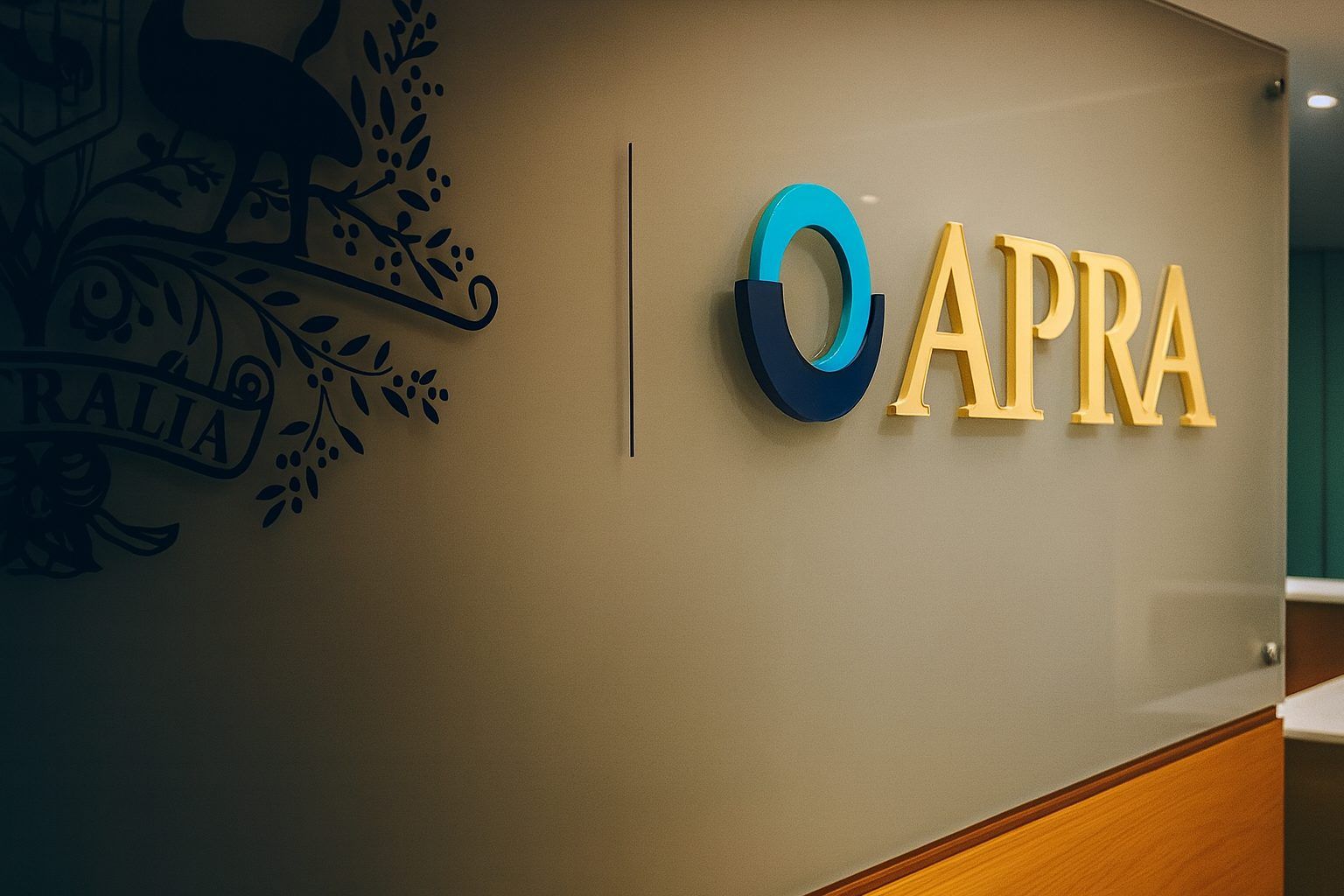27 November 2025 – Australia
Australia’s banking regulator has fired a clear warning shot at the housing boom, unveiling its first‑ever cap on high debt‑to‑income (DTI) mortgages just as markets brace for possible Reserve Bank interest rate hikes in 2026.
On Thursday, the Australian Prudential Regulation Authority (APRA) confirmed that from 1 February 2026, banks and other authorised deposit‑taking institutions will be allowed to write no more than 20% of new home loans at a DTI ratio of six or more, with that cap applied separately to owner‑occupier and investor portfolios. [1]
The move comes amid record housing stress:
- A typical new mortgage now consumes around 45% of a median household’s pre‑tax income, up from 26% in 2020. [2]
- Home values have climbed by about 50% since the pandemic began. [3]
- Property investors now account for about two in every five new loans, with investor lending up roughly 18% in the September quarter alone. [4]
At the same time, inflation has re‑accelerated to 3.8% in the year to October, prompting economists to warn the Reserve Bank of Australia (RBA) may need to raise rates as early as May and again in August next year. [5]
Put together, that’s the “double whammy” facing borrowers: tighter lending rules and the prospect of higher interest rates.
Key points
- APRA introduces a 20% cap on the share of new mortgages with a DTI of six or more, effective 1 February 2026. [6]
- Cap applies separately to owner‑occupier and investor lending; bridging loans and loans for the purchase or construction of new dwellings are exempt. [7]
- Currently, only about 4% of new owner‑occupier loans and 10% of investor loans sit above the six‑times‑income threshold, so the cap is unlikely to bite immediately. [8]
- Treasurer Jim Chalmers welcomes the move as prudent and supportive of financial resilience, while Greens senator Barbara Pocock and housing advocates argue it doesn’t go far enough, especially on investor lending. [9]
- Ratings agencies and bank analysts say the change is a guardrail for stability rather than a handbrake on prices, with the bigger threat to the boom coming from potential RBA rate hikes in 2026. [10]
What exactly has APRA done?
The centrepiece of today’s announcement is a macroprudential cap based on debt‑to‑income ratios.
- A high DTI loan is defined as one where the total amount borrowed is more than six times the borrower’s annual household income. [11]
- From 1 February 2026, banks must ensure that no more than 20% of new lending (by value) falls into that high‑DTI category. [12]
- The 20% limit is calculated separately for owner‑occupier and investor loans, preventing investors from crowding out home buyers within a single shared cap. [13]
APRA has deliberately carved out some exemptions:
- Bridging loans for owner‑occupiers.
- Loans for the purchase or construction of new dwellings, to avoid discouraging much‑needed new housing supply. [14]
The regulator stresses the limits are pre‑emptive, designed to stop risky lending from ramping up as rates drift lower and competition for borrowers intensifies, rather than reacting after a bubble has already formed. [15]
Why now? A housing market on the edge
Today’s lending cap lands in the middle of a severe affordability crunch:
- Servicing a new mortgage now eats up around 45% of a median household’s pre‑tax income, nearly double the burden in 2020. [16]
- Nationally, the home value‑to‑income ratio is around 8.2, up from 6.5 just before the pandemic. [17]
- Since 2020, home values have risen by about 50%, while median incomes have grown only ~20%. [18]
Investors have surged back:
- Property investors now account for about 40% of new loans, a concentration not seen since the mid‑2010s. [19]
- The value of investor lending jumped 18% in the September quarter alone. [20]
On top of that, household debt stands at around 182% of disposable income, one of the highest ratios in the world. [21]
APRA chair John Lonsdale has repeatedly flagged high household indebtedness as a “structural risk” for the financial system, pointing to past episodes when rising leverage, easy credit and booming prices combined into dangerous feedback loops. [22]
Government backs move, Greens say it falls short
The federal government has lined up behind the regulator.
Treasurer Jim Chalmers described the new rules as “prudent steps to maintain responsible lending” and argued they would both reduce risk in the economy and “help when it comes to getting people into homes”. [23]
But not everyone is impressed:
- Greens senator Barbara Pocock says the cap is a “welcome start” but not sufficient, arguing that investors are still outbidding first‑home buyers at weekend auctions and that tighter investor‑specific limits should be on the table. [24]
- Housing advocates and some economists argue APRA can only do so much; to fix affordability, they want broader tax and planning reforms, including changes to the capital gains tax discount and faster housing supply. [25]
The politics are delicate: macroprudential controls are unpopular with some borrowers and investors, but leaving the boom unchecked risks a future bust that could be far more painful.
‘Guardrail, not handbrake’: what analysts are saying
Crucially, APRA’s own numbers show that most banks are currently well below the new 20% ceiling:
- Around 4% of new owner‑occupier loans and 10% of new investor loans have DTIs at or above six. [26]
That’s why many analysts see today’s move as more of a speed sign than a hard brake.
- Fitch Ratings says the cap is unlikely to immediately affect banks or credit growth, but should curb any surge in riskier lending if rates fall or competition heats up, helping contain a key vulnerability in an economy with very high household debt. [27]
- Banking analysts, including those at Barrenjoey and MST Marquee, argue the existing 3‑percentage‑point serviceability buffer — which already requires banks to assess borrowers at a rate three points higher than the actual mortgage rate — is still the main constraint on how much people can borrow. [28]
- Domain and other property researchers say the cap is best viewed as a “guardrail for stability” rather than a tool to cut prices, because the limit is set well above current levels of high‑DTI lending. [29]
The Mortgage & Finance Association of Australia (MFAA) has also backed the rules as “deliberately pre‑emptive rather than reactive”, emphasising that at present most borrowers are managing their mortgages despite cost‑of‑living pressures and that the cap is aimed at preventing future vulnerabilities, particularly in investor lending. [30]
The other hit coming: possible RBA rate hikes
If APRA’s new rules are one half of the “double whammy”, the other is likely to come from monetary policy.
New inflation data released yesterday shows:
- Annual CPI rose to 3.8% in the year to October, up from 3.6%.
- Electricity prices jumped a staggering 37% year on year as state subsidies rolled off. [31]
In response, economists at Barrenjoey and other major institutions now expect the RBA to raise the cash rate in May and again in August 2026, warning that housing‑related inflation — via rents and construction costs — is running too fast to be consistent with the Bank’s 2–3% target. [32]
Higher rates would:
- Cut borrowing capacity for new buyers, as banks recalculate what households can afford under the serviceability buffer.
- Lift repayments for variable‑rate borrowers, many of whom are already devoting nearly half their income to servicing a mortgage. [33]
That’s the “double whammy” AFR’s Chanticleer column warns about: macroprudential caps limiting the riskiest loans, and rate hikes squeezing how much households can safely borrow and repay. [34]
How different groups will feel the change
First‑home buyers and owner‑occupiers
For most would‑be home buyers, very little changes overnight:
- The majority of owner‑occupier loans sit below the six‑times‑income mark.
- Banks are already applying strict serviceability tests, including the 3‑point buffer. [35]
Where buyers might notice an effect is down the track, especially if investor demand accelerates and lenders start to approach the 20% cap in their investor portfolios. To preserve headroom, banks could choose to:
- Tighten criteria slightly for higher‑risk borrowers (e.g. those with multiple debts or unstable income).
- Adjust pricing, making very highly geared loans more expensive relative to conservative ones. [36]
For now, though, experts say most first‑home buyers won’t see immediate changes at the branch level. [37]
Property investors
The rules are most squarely aimed at investors:
- Investors are more likely to borrow at high DTIs, often using equity in existing properties to leverage into additional purchases. [38]
- APRA and the MFAA have both highlighted rising high‑DTI lending to investors from a low base as a key concern. [39]
If banks begin to approach the 20% threshold on investor loans, they may:
- Cap DTI ratios for certain borrowers or property types.
- Prefer lower‑leverage investors with strong incomes and buffers.
- Introduce stricter rental income assumptions or tighter policies on trust and company structures (something some banks have already started doing). [40]
That doesn’t mean investors are locked out, but strategies built on very high leverage will face more headwinds.
Banks and brokers
For the major banks, the cap is another parameter to manage, rather than an immediate constraint.
- Ratings agencies say most banks are comfortably below the new limit, so they should be able to adjust gradually without choking off credit growth. [41]
- The Australian Banking Association has welcomed the “targeted and considered” approach, noting the importance of keeping borrowers within the regulated banking system and not pushing them into higher‑risk non‑bank lenders. [42]
Mortgage brokers, meanwhile, will need to:
- Track each lender’s policy responses as the cap kicks in.
- Help clients understand why some high‑DTI applications are being nudged down or restructured. [43]
Non‑bank lenders and developers
APRA’s rule technically covers authorised deposit‑taking institutions, not non‑bank lenders, but the regulator retains the power to extend macroprudential controls to non‑ADIs if their behaviour threatens system stability. [44]
Fitch does not expect a significant migration of high‑DTI risk into the non‑bank sector, noting it remains relatively small and subject to potential regulatory action. [45]
For developers and builders, the news is relatively benign:
- Loans for the purchase or construction of new dwellings are exempt, deliberately avoiding extra friction around new housing supply — a key priority for governments battling the affordability crisis. [46]
Will this actually cool prices or fix affordability?
The short answer from most experts: no, not on its own.
- Domain’s chief of economics and other analysts expect little direct impact on house prices in the near term, because the cap bites only if high‑DTI lending surges towards 20% of new loans. [47]
- The real levers for affordability remain interest rates, housing supply, and tax settings such as negative gearing and capital gains concessions. [48]
What the cap does is:
- Limit the most extreme borrowing at the edges of the market.
- Reduce the risk that a renewed speculative frenzy, powered by cheap credit and investor leverage, pushes household debt to even more dangerous highs. [49]
In other words, it’s about making the boom less fragile, not making homes suddenly affordable again.
What borrowers and investors can do now
While the new rules don’t start until 1 February 2026, they’re already reshaping conversations between borrowers, brokers and banks. Some general, non‑personal guidance:
- Know your DTI number
- Add up all your debts (home loans, personal loans, credit card balances, car loans).
- Divide that by your household’s gross annual income.
- If you are nudging above six times income, expect more scrutiny, particularly if you’re an investor.
- Stress‑test your budget for higher rates
- Banks already check whether you can afford your loan at a rate three percentage points higher than what you actually pay. [50]
- It’s wise to run your own numbers: ask what happens if your repayment jumps by 20–30%.
- Keep some borrowing capacity in reserve
- In a market where RBA hikes and regulatory limits are both in play, leaving yourself a buffer makes it easier to cope if circumstances or rules shift again.
- For investors: focus on sustainability, not just leverage
- Strong rental yields, cash‑flow resilience and realistic vacancy assumptions matter more than ever when regulators are watching the riskiest loans.
This article is general information only and does not constitute personal financial advice. Always consider getting advice tailored to your own circumstances before making borrowing or investment decisions.
The bottom line
27 November 2025 marks a turning point in Australia’s long‑running housing story. For the first time, APRA has set a formal cap on high debt‑to‑income lending, putting a clear boundary around how far households — and their lenders — can stretch.
On its own, the 20% limit won’t burst the property boom or rescue affordability. But in combination with a likely shift towards higher interest rates in 2026, it signals that policymakers are no longer prepared to watch the housing market heat up unchecked.
For heavily leveraged borrowers and would‑be investors, the era of “extend and pretend” is over. The new game is about resilience: stronger buffers, more sustainable borrowing, and a housing market that can withstand the next shock rather than amplify it.
References
1. www.abc.net.au, 2. www.theguardian.com, 3. www.theguardian.com, 4. www.theguardian.com, 5. www.theguardian.com, 6. www.abc.net.au, 7. www.abc.net.au, 8. www.abc.net.au, 9. www.abc.net.au, 10. www.tradingview.com, 11. www.abc.net.au, 12. www.abc.net.au, 13. www.abc.net.au, 14. www.abc.net.au, 15. www.abc.net.au, 16. www.theguardian.com, 17. www.theguardian.com, 18. www.theguardian.com, 19. www.theguardian.com, 20. www.theguardian.com, 21. www.tradingview.com, 22. www.abc.net.au, 23. www.abc.net.au, 24. www.abc.net.au, 25. www.theguardian.com, 26. www.abc.net.au, 27. www.tradingview.com, 28. www.abc.net.au, 29. www.theguardian.com, 30. www.mfaa.com.au, 31. www.theguardian.com, 32. www.theguardian.com, 33. www.theguardian.com, 34. www.afr.com, 35. www.abc.net.au, 36. www.abc.net.au, 37. www.abc.net.au, 38. www.theguardian.com, 39. www.abc.net.au, 40. www.mfaa.com.au, 41. www.tradingview.com, 42. www.abc.net.au, 43. www.mfaa.com.au, 44. www.abc.net.au, 45. www.tradingview.com, 46. www.abc.net.au, 47. www.abc.net.au, 48. www.theguardian.com, 49. www.tradingview.com, 50. www.abc.net.au










